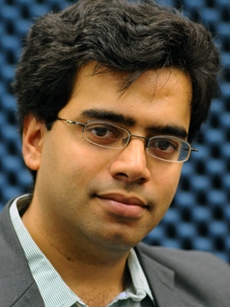
Harish Krishnaswamy, associate professor of electrical engineering, Columbia University
A team of Columbia University researchers believes that enabling reliable and efficient full duplex wireless communication is a task best addressed at the chip level. The researchers, led by Harish Krishnaswamy, an associate professor of electrical engineering, have developed full-duplex radio integrated circuits that can be implemented in nanoscale CMOS to enable simultaneous transmission and reception on the same frequency. "Having a transmitter and receiver use the same frequency offers the potential to immediately double network data capacity," Krishnaswamy says. "Our work is the first to demonstrate an IC that can receive and transmit simultaneously," he says. CMOS is the dominant technology used for radio ICs inside phones and other radio-equipped mobile devices. The biggest challenge the team faced during its research was canceling transmitter echo, a phenomenon that makes usable full duplex impossible. "What you really need to do is to cancel-out that echo to the point where it's eliminated almost perfectly and the residual echo is extremely small - smaller than the received signal, the desired signal - that you're trying to receive from the distant cell tower," he says. Since the echo is over a billion times more powerful than the received signal, echo cancellation circuits must operate highly precisely. "We need echo cancellation circuits that are something like one-part-per-billion-level accurate," Krishnaswamy explains. Such precision is difficult to achieve in software alone without killing overall device performance. "This really is something that needs to be done in hardware," Krishnaswamy says. "That level of precision in the echo cancellation, and the need to handle such a loud echo, cannot be done purely in signal processing." To achieve optimal quality, the researchers applied multiple layers of echo cancellation to their software. "The echo is at least a billion to 10 billion times more powerful than the signal that we're trying Columbia to receive, so basically you want to cancel that factor, and that's hard to do with one signal echo canceller," Krishnaswamy says. "So the way these full duplex systems are likely to be successful is to have multiple layers of echo cancellation, just hitting that echo canceling again, and again, and again. Krishnaswamy and doctoral student Jin Zhou are now testing the full-duplex technology on various nodes to understand exactly what gains might be possible at the network level. "We are looking forward to being able to deliver the promised performance improvements," Krishnaswamy says. Source domain-b.com
